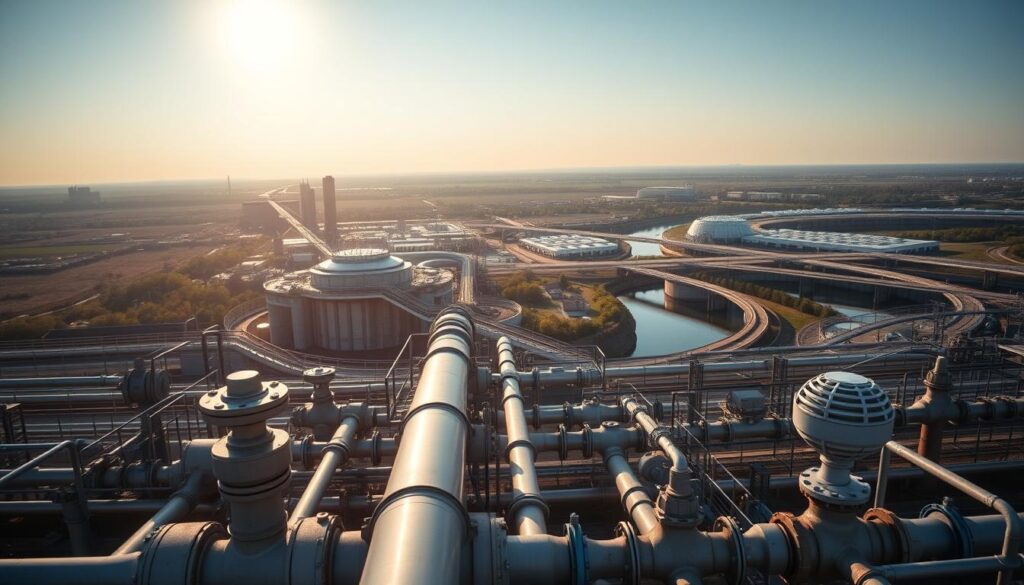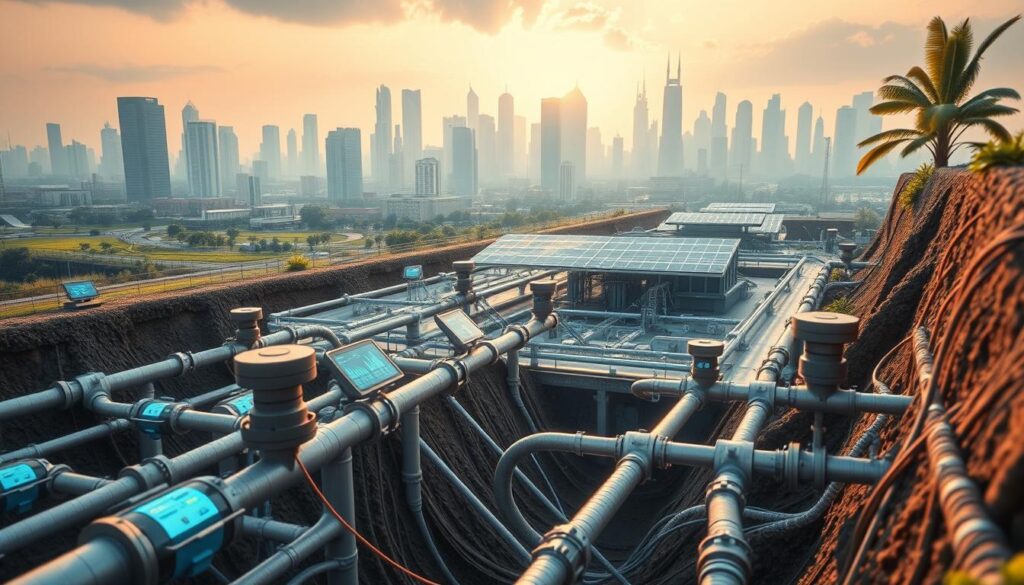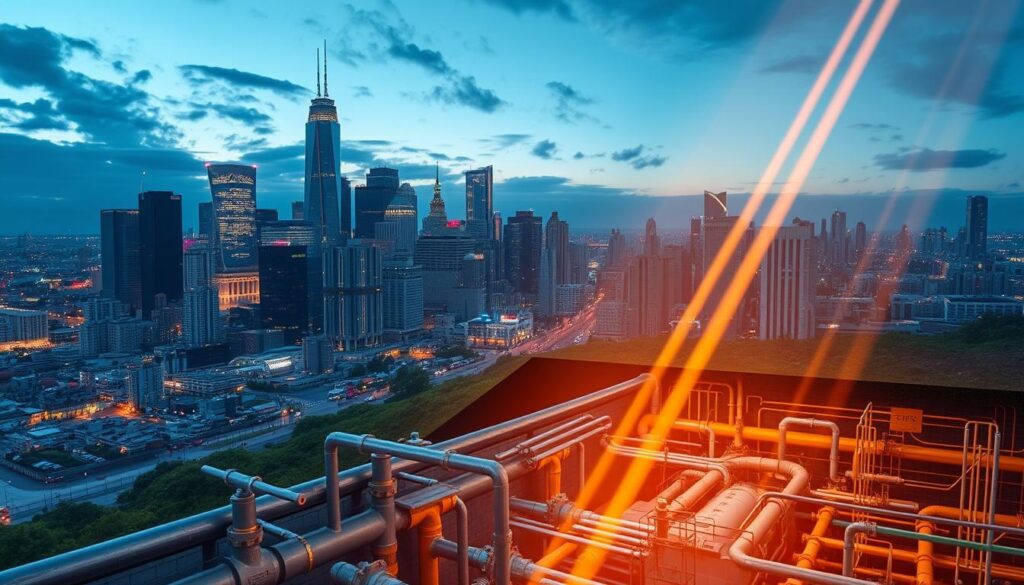As cities continue to grow, the strain on urban water infrastructure becomes increasingly evident. The question on everyone’s mind is: How can we make our water management systems more efficient and sustainable? The answer lies in leveraging cutting-edge engineering insights to optimize these systems.
Recent research highlights the crucial role of artificial intelligence and smart technologies in enhancing the sustainability of urban development. By integrating these advanced technologies, cities can significantly improve their water infrastructure, making it more resilient and adaptable to future challenges.
Key Takeaways
- Efficient water management is crucial for sustainable urban development.
- Advanced engineering insights can significantly optimize urban water infrastructure.
- The integration of smart technologies enhances the resilience of water systems.
- Artificial intelligence plays a key role in improving water infrastructure sustainability.
- Effective project management is essential for successful water infrastructure projects.
Understanding Urban Water Infrastructure Engineering
Effective urban water infrastructure engineering is essential for maintaining public health and environmental sustainability in urban environments. This field encompasses a broad range of activities, including the design, construction, and maintenance of systems that manage water resources.
Definition and Importance
Urban water infrastructure engineering refers to the design and management of systems that supply clean water, manage wastewater, and mitigate the effects of urban flooding. The importance of this field cannot be overstated, as it directly impacts the health and well-being of urban populations. Properly managed water infrastructure prevents the spread of waterborne diseases and ensures that water resources are used sustainably.
According to recent studies, urban water infrastructure includes water treatment plants, reservoirs, pumps, and distribution networks, all of which are crucial for providing clean water and managing wastewater. Advances in civil engineering and environmental science have led to more efficient and sustainable practices in this field.
Key Components of Urban Water Systems
Urban water systems are complex and multifaceted, comprising several key components. These include:
- Water supply systems that source and distribute water
- Wastewater collection and treatment systems
- Urban drainage systems that manage stormwater runoff
| Component | Description | Importance |
|---|---|---|
| Water Supply Systems | Source and distribute water to meet urban demands | Essential for drinking water, sanitation, and hygiene |
| Wastewater Collection and Treatment | Collect and treat wastewater to prevent environmental pollution | Critical for maintaining environmental sustainability and public health |
| Urban Drainage Systems | Manage stormwater runoff to prevent urban flooding | Vital for protecting urban infrastructure and preventing property damage |
Understanding these components and their interconnections is crucial for effective urban water infrastructure engineering. By leveraging advances in technology and engineering practices, cities can improve the resilience and sustainability of their water systems.
Historical Overview of Urban Water Infrastructure

Urban water infrastructure has evolved substantially over time, from ancient civilizations to modern sustainable urban development practices. The history of water supply systems is a testament to human ingenuity and the need for efficient water management systems.
Evolution of Water Supply Systems
The evolution of urban water supply systems has been a gradual process, marked by significant milestones. Ancient civilizations such as Rome and Egypt developed sophisticated systems to supply water to their cities. These early systems were crucial in supporting urban populations and facilitating growth. As noted by historians, “The construction of aqueducts and canals was a hallmark of ancient engineering prowess.” Historical records highlight the importance of these early water management practices.
In modern times, the focus has shifted towards sustainable urban development and the integration of advanced wastewater treatment technologies. Cities now employ a range of strategies to manage water resources effectively, from water recycling to the use of green infrastructure.
Major Engineering Milestones
Several major engineering milestones have shaped the development of urban water infrastructure. The construction of sewage systems in the 19th century, for example, significantly improved public health by reducing the incidence of waterborne diseases. More recently, advancements in wastewater treatment technologies have enabled cities to reclaim and reuse water, reducing the strain on potable water supplies.
“The development of modern wastewater treatment technologies has been instrumental in improving water quality and supporting urban sustainability initiatives.”
These advancements underscore the importance of continued investment in urban water infrastructure. As cities continue to grow and face new challenges, the evolution of water management systems will remain crucial to sustainable urban development.
Challenges in Urban Water Infrastructure Today
Aging infrastructure, climate change, and rapid urbanization are among the pressing issues affecting urban water systems today. These challenges not only strain existing resources but also threaten the sustainability and resilience of urban water infrastructure.
Aging Infrastructure
Many urban water systems in the United States are grappling with aging infrastructure, including pipes, treatment plants, and distribution networks. The deterioration of these systems can lead to leaks, contaminant intrusion, and service disruptions, ultimately affecting water quality and public health.
- Leaks and water main breaks result in significant water loss and infrastructure repair costs.
- Aging treatment plants may struggle to meet modern water quality standards.
- Infrastructure failures can have cascading effects on other urban systems, such as transportation and energy.
Climate Change Impacts
Climate change poses a significant threat to urban water infrastructure, with rising temperatures and changing precipitation patterns affecting water availability and quality. Engineers are working to develop climate-resilient water that can adapt to these changes.
- Increased frequency and severity of extreme weather events, such as floods and droughts.
- Shifts in water supply due to changes in snowpack and precipitation patterns.
- Rising sea levels and saltwater intrusion into freshwater sources.
Population Growth and Urbanization
Rapid urbanization and population growth place additional demands on urban water infrastructure, requiring innovative solutions to manage water resources sustainably. As cities expand, their water systems must be able to accommodate increased demand while maintaining water quality and minimizing environmental impacts.
- Water conservation measures and efficient use technologies.
- Expansion of water treatment and recycling facilities.
- Implementation of smart water management systems to optimize distribution and detection of leaks.
Addressing these challenges will require a multifaceted approach that incorporates engineering innovation, sustainable practices, and effective policy frameworks to ensure the long-term viability of urban water infrastructure.
Innovative Engineering Solutions for Urban Water

Innovative engineering solutions are revolutionizing urban water infrastructure, enhancing efficiency and reducing environmental impacts. The integration of smart water management technologies and green infrastructure approaches is transforming urban water management, making it more sustainable and resilient.
Smart Water Management Technologies
Smart water management technologies involve the use of advanced sensors, data analytics, and IoT devices to monitor and manage water distribution systems more effectively. These technologies help in detecting leaks, predicting water demand, and optimizing water supply.
Key Features of Smart Water Management:
- Real-time monitoring of water quality and quantity
- Advanced data analytics for predictive maintenance
- Automated control systems for efficient water distribution
Green Infrastructure Approaches
Green infrastructure approaches focus on using natural or semi-natural systems to manage urban water resources sustainably. This includes the implementation of green roofs, rain gardens, and permeable pavements to reduce stormwater runoff and improve water quality.
For more insights on tackling grand challenges in engineering, visit World Civil Society.
| Green Infrastructure | Benefits | Examples |
|---|---|---|
| Green Roofs | Reduces stormwater runoff, improves insulation | Chicago City Hall, Chicago |
| Rain Gardens | Enhances biodiversity, filters rainwater | Prince George’s County, Maryland |
| Permeable Pavements | Reduces runoff, recharges groundwater | Portland, Oregon |
By combining smart water management technologies with green infrastructure approaches, cities can create a more sustainable and resilient urban water infrastructure. This integrated approach not only addresses current challenges but also prepares cities for future water management needs.
Water Quality Management Strategies
Effective water quality management is crucial for maintaining public health and environmental sustainability. Urban water infrastructure engineering plays a vital role in ensuring that water management systems are efficient and reliable.
Water quality management involves a combination of monitoring water quality and applying appropriate treatment techniques. Monitoring is essential to identify contaminants and assess the overall health of water bodies.
Monitoring Water Quality
Monitoring water quality is the first step in managing water resources effectively. It involves collecting and analyzing water samples to detect physical, chemical, and biological contaminants. Advanced technologies, such as remote sensing and real-time monitoring systems, have improved the accuracy and efficiency of water quality monitoring. For more detailed information on water quality monitoring, refer to the USGS report on water quality assessment.
Regular monitoring helps in early detection of pollution sources, enabling prompt action to mitigate their impact. It also aids in evaluating the effectiveness of water management policies and infrastructure.
Treatment Techniques
Once water quality issues are identified, appropriate treatment techniques must be applied. Wastewater treatment technologies are critical in removing contaminants from wastewater before it is discharged into the environment or reused. Various treatment methods, including physical, chemical, and biological processes, are employed to remove different types of pollutants.
The choice of treatment technique depends on the type and concentration of contaminants, as well as the intended use of the treated water. Advanced treatment technologies, such as membrane filtration and advanced oxidation processes, are increasingly being adopted to meet stringent water quality standards.
Effective water quality management strategies are essential for protecting public health and the environment. By combining robust monitoring with appropriate treatment techniques, we can ensure the sustainability of our water resources.
Sustainable Practices in Urban Water Engineering

Sustainable urban development relies heavily on innovative water management systems and green infrastructure design. As cities continue to grow, the strain on existing water infrastructure intensifies, making the adoption of sustainable practices crucial.
Water Conservation Methods
Effective water conservation is key to sustainable urban water management. This involves implementing strategies such as low-flow fixtures, efficient irrigation systems, and public education campaigns to reduce water consumption. For instance, cities can promote the use of drought-resistant landscaping and implement water-saving technologies in buildings.
A study on urban water conservation methods revealed that implementing such strategies can significantly reduce the demand on urban water supplies. According to the Sustainability Directory, sustainable practices like water conservation are critical for enhancing urban water sustainability.
| Conservation Method | Description | Potential Water Savings |
|---|---|---|
| Low-flow Fixtures | Installation of faucets and toilets that use less water | Up to 30% |
| Efficient Irrigation Systems | Smart irrigation controllers that adjust based on weather | Up to 20% |
| Public Education Campaigns | Awareness programs to encourage water-saving habits | Variable, up to 15% |
Rainwater Harvesting Systems
Rainwater harvesting is another effective strategy for sustainable urban water management. By collecting and storing rainwater for non-potable uses such as irrigation, toilet flushing, and washing machines, cities can reduce their reliance on municipal water supplies. Rainwater harvesting systems can be integrated into new buildings or retrofitted into existing infrastructure.
The benefits of rainwater harvesting include reduced stormwater runoff, decreased demand on municipal water supplies, and potential cost savings for building owners. As cities look to adopt more sustainable practices, rainwater harvesting systems are becoming an increasingly important component of urban water management strategies.
Financing Urban Water Infrastructure Projects
The financial backbone of urban water infrastructure projects relies heavily on identifying viable funding sources and conducting thorough cost-benefit analyses. Effective financing is crucial for the successful implementation and sustainability of these projects.
Funding Sources
Urban water infrastructure projects can be financed through various funding sources. These include:
- Government Grants: Federal and state governments provide grants for water infrastructure projects, especially those that incorporate innovative technologies or green infrastructure.
- Municipal Bonds: Cities issue bonds to finance large-scale water infrastructure projects, spreading the cost over time.
- Public-Private Partnerships (PPPs): Collaborations between government agencies and private companies can provide necessary funding and expertise.
- Loans and Credits: Low-interest loans from government agencies or financial institutions can help municipalities fund water projects.
According to a report by the EPA, leveraging multiple funding sources can help alleviate the financial burden on local governments and ensure the long-term viability of water infrastructure projects.
Cost-Benefit Analyses
Conducting thorough cost-benefit analyses is essential for evaluating the economic viability of urban water infrastructure projects. This involves:
- Identifying Costs: Assessing initial investment, maintenance, and operational costs.
- Assessing Benefits: Evaluating the economic, social, and environmental benefits of the project, such as improved water quality and reduced flood risk.
- Comparing Alternatives: Analyzing different project designs or technologies to determine the most cost-effective solution.
By carefully considering these factors, municipalities can make informed decisions that balance financial constraints with the need for sustainable and resilient water infrastructure.
Regulatory and Policy Frameworks

Regulatory and policy frameworks play a crucial role in shaping the future of urban water infrastructure engineering. These frameworks, established at both federal and local levels, guide the development, management, and operation of urban water systems.
Federal Regulations
Federal regulations provide a foundational layer of governance for urban water infrastructure. Key federal regulations include:
- The Clean Water Act, which regulates discharges of pollutants into the nation’s waters.
- The Safe Drinking Water Act, which ensures the quality of drinking water.
For more information on federal regulations, visit the American Planning Association’s water policy guide.
Local Government Policies
Local government policies complement federal regulations by addressing specific regional needs and challenges. These policies can include:
- Zoning laws that dictate land use near water sources.
- Ordinances that govern stormwater management.
Effective local policies are crucial for sustainable urban development and the implementation of efficient water management systems.
In conclusion, the interplay between federal regulations and local government policies forms a comprehensive framework that guides urban water infrastructure engineering. Understanding and navigating these frameworks is essential for developing sustainable and resilient urban water systems.
Community Engagement and Awareness
Community awareness and engagement are vital components in the planning and implementation of urban water management systems. Effective public involvement can lead to more sustainable and resilient water infrastructure.
Public Involvement
The importance of public involvement cannot be overstated. It ensures that the needs and concerns of the community are addressed in the planning process. Public engagement strategies can include public meetings, surveys, and collaborative planning processes.
By engaging the public, urban planners can gather valuable insights into community preferences and priorities, ultimately leading to more effective and sustainable urban development.
Educational Outreach Strategies
Educational outreach is a critical component of community engagement. It involves informing the public about the benefits and challenges associated with urban water infrastructure projects. Strategies can include workshops, educational materials, and digital media campaigns.
For instance, educating the public about green infrastructure design can help build support for innovative water management solutions. This can lead to more effective water management systems that benefit both the community and the environment.
By combining public involvement with educational outreach, cities can foster a more informed and engaged citizenry, ultimately contributing to the success of urban water infrastructure projects.
Case Studies in Successful Urban Water Engineering

Analyzing case studies from major U.S. cities reveals crucial lessons in successful urban water engineering practices. These cities have implemented various smart water infrastructure solutions that have significantly improved their water management capabilities.
Examples from Major U.S. Cities
Cities like New York, Los Angeles, and Chicago have been at the forefront of adopting innovative urban water engineering solutions. For instance, New York City’s water conservation programs have reduced water consumption significantly. Los Angeles has invested heavily in climate-resilient water systems to combat droughts and floods.
Chicago’s efforts in upgrading its water infrastructure have not only improved water quality but also enhanced the city’s resilience to climate change impacts. These examples demonstrate the effectiveness of tailored approaches to urban water management.
Lessons Learned
The case studies from these major U.S. cities provide several key lessons. Firstly, the importance of integrating smart water technologies into existing infrastructure cannot be overstated. Secondly, community engagement and public awareness are crucial for the success of urban water projects.
Lastly, the adoption of sustainable practices in urban water engineering, such as rainwater harvesting and green infrastructure, has shown significant benefits in terms of cost savings and environmental impact.
By examining these case studies, urban planners and engineers can gain valuable insights into designing and implementing effective urban water infrastructure projects that are resilient, sustainable, and responsive to community needs.
Role of Technology in Urban Water Infrastructure
Technological advancements are playing a crucial role in enhancing the efficiency and resilience of urban water systems. The integration of various technologies is transforming the way cities manage their water resources, making the systems more sustainable and responsive to the needs of the population.
Data Analytics and Management
Data analytics is at the forefront of this technological revolution, enabling cities to make informed decisions about their water infrastructure. By analyzing data from various sources, including sensors and monitoring systems, cities can optimize water distribution, detect leaks, and predict future demand.
- Predictive Maintenance: Advanced data analytics allows for predictive maintenance, reducing the likelihood of infrastructure failures and improving overall system reliability.
- Real-time Monitoring: Real-time data monitoring enables cities to respond quickly to changes in water demand or supply, ensuring a more efficient management of resources.
Remote Sensing Technologies
Remote sensing technologies are another critical component in the modernization of urban water infrastructure. These technologies allow for the collection of data on water resources and infrastructure without direct physical contact, providing valuable insights into the condition and performance of the system.
Applications of Remote Sensing include:
- Monitoring water quality and detecting changes in water bodies.
- Assessing the health of watersheds and identifying areas at risk.
- Mapping flood risks and planning mitigation strategies.
By leveraging these technologies, cities can develop more effective strategies for managing their water resources, ultimately leading to more sustainable and resilient urban water infrastructure.
Future Trends in Urban Water Infrastructure Engineering

Predictive modeling and the integration of AI and IoT are emerging as key trends in enhancing the sustainability and resilience of urban water infrastructure.
The use of predictive modeling allows for the anticipation of potential failures and inefficiencies in water distribution systems, enabling proactive maintenance and reducing the likelihood of catastrophic failures.
Predictive Modeling
Predictive modeling involves the use of statistical and machine learning techniques to forecast future events based on historical data. In the context of urban water infrastructure, predictive modeling can be used to:
- Predict pipe failures and prioritize maintenance
- Optimize water treatment processes
- Forecast water demand and adjust supply accordingly
| Application | Benefits |
|---|---|
| Predicting Pipe Failures | Reduced maintenance costs, minimized disruptions |
| Optimizing Water Treatment | Improved water quality, reduced chemical usage |
| Forecasting Water Demand | Efficient resource allocation, reduced waste |
Integration of AI and IoT
The integration of AI and IoT technologies is transforming urban water management by providing real-time monitoring and control capabilities. IoT sensors can be used to monitor water quality, detect leaks, and track water levels, while AI algorithms can analyze this data to identify patterns and make predictions.
For instance, IoT devices can be deployed in water distribution networks to detect anomalies and alert operators to potential issues before they become major problems. AI can then be used to analyze data from these devices to predict future issues and recommend corrective actions.
The future of urban water infrastructure engineering is closely tied to the adoption of these emerging technologies. By leveraging predictive modeling and the integration of AI and IoT, cities can create climate-resilient water systems that are capable of withstanding the challenges posed by climate change.
Collaboration Among Stakeholders
The development of sustainable urban water systems relies heavily on the cooperation among various stakeholders. Effective collaboration ensures that urban water infrastructure projects are not only technically sound but also meet the needs of the community and are financially viable.
Public-Private Partnerships
Public-private partnerships (PPPs) have emerged as a crucial mechanism for financing and delivering urban water infrastructure projects. By leveraging the strengths of both the public and private sectors, PPPs can bring about efficiency, innovation, and financial sustainability to these projects. For instance, a PPP can enable the sharing of risks between the public and private partners, making it possible to undertake projects that might be too costly or risky for one sector to handle alone.
According to recent studies, PPPs in urban water infrastructure have shown significant benefits, including improved service delivery and reduced costs. For more insights on how PPPs are applied in project management, visit this resource on civil engineering in project management.
Engagement with Nonprofits
Engagement with nonprofit organizations is another vital aspect of stakeholder collaboration in urban water infrastructure. Nonprofits often bring valuable expertise, community insight, and advocacy to the table, helping to ensure that projects are socially acceptable and environmentally sustainable. Community engagement facilitated by nonprofits can also enhance public acceptance and support for urban water projects.
Nonprofits can play a role in educating the public about the importance of water conservation and the benefits of sustainable water management practices. By working together with government agencies, private companies, and other stakeholders, nonprofits can help create a more holistic approach to urban water management.
Conclusion: The Future of Urban Water Infrastructure Engineering
As cities continue to grow and face increasing water management challenges, the need for innovative and sustainable urban water infrastructure engineering solutions becomes more pressing. The shift towards scaled decentralization is a promising approach, offering reduced life-cycle costs, lowered environmental impact, and improved resilience.
Embracing smart water infrastructure solutions is crucial for achieving sustainable urban development. This involves integrating cutting-edge technologies, such as data analytics and predictive modeling, into urban water systems.
Key Takeaways and Future Directions
The future of urban water infrastructure engineering depends on collaborative stakeholder engagement, the adoption of sustainable practices, and the integration of innovative technologies. By working together, engineers and policymakers can create more resilient and sustainable urban water systems.
Call to Action
Engineers and policymakers must collaborate to drive the adoption of smart water infrastructure solutions, ensuring that urban water systems are equipped to meet the challenges of the future. This partnership is essential for achieving sustainable urban development and securing a water-resilient future.
